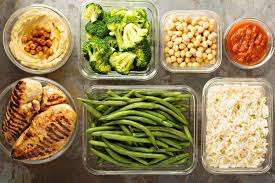Whether you are training for a marathon, building strength, or simply working towards fitness goals, muscle recovery is essential for optimal performance.
If you are pushing yourself hard in the gym but feel drained, fatigued, or stagnant, weekly diet breaks can be a game-changer.
Strategic diet breaks (to keep you away from binge eating) not only help you refuel physically but also mentally recharge, giving your body a much-needed break from the calorie deficits or strict meal plans associated with fitness regimes.
In this article, we will analyze how to incorporate weekly diet breaks effectively to maximize muscle recovery, avoid burnout, and maintain long-term fitness progress.
Points Covered in this Article:
- What is a Diet Break?
- The Importance of Muscle Recovery
- How Diet Breaks Aid in Muscle Recovery
- Planning Your Weekly Diet Break
- What to Eat During a Weekly Diet Break
- Incorporating Diet Breaks Without Derailing Progress
- FAQs on Weekly Diet Breaks for Muscle Recovery
- Common Pitfalls and How to Avoid Them
- Conclusion
What is a Diet Break?
A diet break is a planned, short-term increase in caloric intake, typically spread over a few days or a week, designed to help your body recover from the stresses of dieting and exercise.
It is not a free-for-all binge but a controlled and intentional phase where you increase your calorie intake (usually by about 20-30%) with the goal of providing your muscles with more fuel to repair and grow.
Example: Sarah, a competitive weightlifter, includes a diet break after every six weeks of intense training. This allows her to reset mentally and physically without losing the gains she’s worked so hard to achieve.

The Importance of Muscle Recovery
Muscle recovery is more than just taking breaks between workouts. It is a crucial process that allows muscles to repair, grow, and function efficiently. Without proper recovery, individuals may experience fatigue, weakened performance, and even muscle loss.
Below are some key aspects of muscle recovery:
1. Understanding Muscle Recovery:
- During weightlifting or resistance training, microscopic tears occur in muscle fibers. Recovery processes repair these tears, leading to muscle growth and improved strength.
- Proper recovery helps reduce muscle soreness, enhances flexibility, and prevents long-term injuries.
2. Consequences of Poor Recovery:
- Overtraining without sufficient rest can lead to Overtraining Syndrome, which includes symptoms like chronic fatigue, mood disturbances, and increased susceptibility to injuries (Healthline).
- A weakened immune system and persistent muscle soreness are also common consequences of inadequate recovery (Healthline).
3. Effective Recovery Strategies:
- Active Recovery: Engaging in low-intensity exercises like yoga, swimming, or walking on rest days enhances circulation, reduces stiffness, and speeds up muscle repair (Healthline).
- Stretching: Incorporating stretching routines post-workout improves flexibility, reduces muscle tension, and decreases the risk of injuries (Healthline).
- Massage Therapy: Massages can alleviate muscle soreness, decrease inflammation, and promote faster recovery (Mayo Clinic).
4. Nutrition for Muscle Recovery:
- Protein Intake: Consuming sufficient protein within two hours post-exercise aids in muscle repair and growth (Verywell Health).
- Carbohydrates: Replenishing glycogen stores by consuming carbs post-workout restores energy and supports recovery (Verywell Health).
- Hydration: Staying hydrated is essential for optimal muscle function and recovery (Healthline).
5. Signs of Overtraining:
- Persistent muscle soreness that does not improve with rest may indicate overtraining (WebMD).
- A consistently high resting heart rate could be a sign of inadequate recovery (Wikipedia).
- Mood swings, irritability, and lack of motivation can be associated with overtraining (Healthline).
6. Importance of Rest Days:
- Scheduling regular rest days allows muscles to repair, preventing overuse injuries and optimizing performance (Healthline).
By incorporating proper recovery strategies, individuals can ensure sustainable muscle growth, reduce the risk of injuries, and improve overall physical performance.

How Diet Breaks Aid in Muscle Recovery?
When you’re on a calorie deficit for fat loss or muscle cutting, your body’s energy reserves are limited.
While this helps reduce fat, it can also lead to muscle breakdown if maintained for too long. A diet break allows your body to replenish glycogen stores and gives muscles the nutrients they need to repair and grow.
A study from the International Journal of Obesity found that individuals who included strategic diet breaks in their regimes maintained more muscle mass and strength compared to those who didn’t incorporate breaks.
Think of it like this: just as you need rest between workouts, your muscles need a caloric “rest” for full recovery.
Example: John, an endurance runner, follows intermittent fasting but includes a weekly break to avoid muscle degradation. He uses this break to ensure his body recovers and avoids the risk of injury from long-distance runs.
>>> Want to Learn My “Secret Weekly Diet Breaks” for Muscle Recovery??? Click Here to Find Out!<<<
Planning Your Weekly Diet Break
To incorporate diet breaks effectively, it is essential to plan them based on your training cycles and fitness goals.
A well-planned diet break can last anywhere from 3 to 7 days and should ideally follow a phase of calorie restriction or intense training.
Start by slowly increasing your calorie intake by 20-30%. This can be through healthy, nutrient-dense foods like lean proteins, complex carbohydrates, and healthy fats.
Focus on quality over quantity to avoid unnecessary weight gain. So, calorie counting in meal planning is an ideal way to achieve your fitness goals.
Example: Maria, who practices intermittent fasting, takes a weekly diet break after every 5-day fasting window. On her break, she increases her intake to support muscle recovery and to refuel her energy stores.
What to Eat During a Weekly Diet Break?
Wondering what to eat after fasting for 7 days or following a strict calorie restriction phase?
The goal during a weekly diet break isn’t to binge—it is to strategically refuel your body, stabilize metabolism, and support muscle recovery while keeping digestion smooth and nutrient intake high.
Protein:
Focus on lean proteins like grilled chicken, turkey breast, tofu, tempeh, legumes, or fish such as salmon and tuna. Protein is critical for muscle repair and satiety. You just need to learn how to choose the best protein for your muscle recovery.
According to a study in the Journal of the International Society of Sports Nutrition, maintaining a high-protein intake during refeeding helps preserve lean mass and prevents fat regain.
Carbohydrates:
Your glycogen stores are likely depleted, especially if your diet involved low-carb intake or extended fasting. Reintroduce complex carbs like brown rice, oats, lentils, sweet potatoes, and whole grains.
These slowly digesting carbs not only replenish glycogen but also help balance blood sugar levels and reduce cravings. A 2021 meta-analysis emphasized the role of whole-food carbs in improving insulin sensitivity post-dieting.
Fats:
Don’t shy away from healthy fats. Avocados, olive oil, nuts, chia seeds, and fatty fish offer omega-3s and monounsaturated fats, which lower inflammation and support hormone balance.
Refeeding studies have shown that moderate fat intake can help normalize leptin levels, the hormone that regulates hunger.
Go Easy on the Gut:
After a fast or low-calorie phase, your digestive system needs a gradual ramp-up. Start with easy-to-digest foods in moderate portions.
Avoid ultra-processed food items and refined sugars, which can spike insulin and trigger bloating or fatigue. Always include good gut bacteria to maintain ideal body weight naturally.
Example:
Lisa, after a 7-day intermittent fast, eases back with a meal of grilled salmon, steamed zucchini, and a small serving of quinoa.
This combo gives her high-quality protein, fiber-rich carbs, and anti-inflammatory fats—everything her body needs to recover smartly without overwhelming her system.
In short, think “nourish” not “indulge” during your break.
Incorporating Diet Breaks Without Derailing Progress
One common concern when incorporating weekly diet breaks is whether it will hinder progress.
The key is to ensure that your diet break is not an excuse to eat recklessly but rather a tool to support long-term success.
Make sure to track your calories even during the break to stay within a controlled surplus.
If you are worried about over-consuming, start with a modest increase in calories and gauge how your body responds.
Consider your diet break a form of strategic refeeding rather than simply “breaking the diet.”
Example: For his diet break, Ben increases his daily intake by 400 calories but keeps his focus on whole foods to ensure he does not derail his progress. He continues to hit the gym but reduces intensity to avoid overexertion.
FAQs on Weekly Diet Breaks for Muscle Recovery
Q-1: What exactly is a “weekly diet break,” and how is it different from a cheat day?
A-1: A weekly diet break is 1–2 planned days at true maintenance calories (not a free-for-all) to restore training output and mood while you’re in a deficit the rest of the week. You need to maintain a sustainable diet for healthy living. For that you keep protein high, keep fiber in, and bias extra calories toward carbs around workouts. A cheat day ignores targets and usually overshoots maintenance; a diet break has numbers, times, and a purpose: better recovery without erasing weekly fat loss.
Q-2: How do I set calories and macros for a break day without gaining fat?
A-2: Estimate maintenance as your current average weekly intake plus the rate of loss converted to calories (e.g., losing ~0.5 kg/week ≈ ~500 kcal/day deficit → add ~500 kcal on break days). Keep protein at 1.6–2.2 g/kg, fat at 0.6–0.8 g/kg, and place most added calories as carbs (2–3 g/kg total) around training. The goal is glycogen and performance, not dessert volume.
Q-3: Which training days should host my break, and how do I place meals?
A-3: Park break days on your highest-tension or most skill-demanding sessions (e.g., lower-body strength or high-volume push/pull). Front-load carbs pre- and post-workout: 25–35% of daily calories in the 3–4 hours before, another 25–35% within 2 hours after. Keep an ordinary dinner—don’t “celebrate” with a blowout. You’ll feel stronger in-session and less wrecked the next day.
Q-4: What signs tell me I need a weekly break vs. staying in the deficit?
A-4: Add a break if two or more persist for 5–7 days: rising session RPE at the same loads, poorer sleep or morning energy, resting heart rate up ~3–5 bpm, flat or falling training numbers, low mood/irritability, or hunger that spills into late-night grazing. Also, learn the art of maintaining your diet while eating out. Skip or shorten the break if weight has plateaued and steps are down or logging is sloppy—fix consistency first.
Q-5: How do I know if breaks are “working,” and what if the scale jumps?
A-5: Judge by performance and trend, not one morning weigh-in. Expect 0.3–1.0 kg of transient scale rise from glycogen and water after a carb-rich break—waist should stay steady. Track: (1) weekly average weight and waist (downward trend over 2–4 weeks), (2) top-set loads/reps (stable or improving), (3) sleep and mood notes. If fat loss stalls for 2+ weeks despite adherence, trim 100–150 kcal from non-break days or reduce break frequency to one day/week.

Common Pitfalls and How to Avoid Them
It is easy to fall into common traps during diet breaks, especially if you have been in a calorie deficit for a long time.
Here is how to avoid them:
- Overeating: Do not let your diet break turn into an all-out binge. Track your intake and stay mindful of portion sizes.
- Poor food choices: Stick to nutrient-dense foods rather than junk food. Incorporating high-quality foods will help you feel better and support muscle recovery.
- Not adjusting back: After your break, ease back into your regular routine. Sudden drastic changes in diet can lead to discomfort or unwanted weight gain.
If you have been stuck in a fitness rut, using diet breaks can even help break through a weight loss plateau by resetting your metabolism and giving your body a fresh start.
Example: Tom had plateaued in his weight loss, so he incorporated a weekly diet break.
The influx of calories helped reset his metabolism, and when he resumed his diet, his weight loss progress picked up again.
Takeaway
Incorporating weekly diet breaks can be one of the most effective ways to support muscle recovery, prevent burnout, and maintain long-term fitness progress.
Whether you are an athlete or a casual gym-goer, regular, planned diet breaks ensure that your muscles are properly refueled and repaired, allowing you to keep moving forward without sacrificing muscle mass or performance.
The key to success is planning and mindfulness—control your calorie intake, focus on nutrient-dense foods, and remember that a diet break is not a license to binge but a strategic tool in your fitness arsenal.
Whether you are wondering will Coke Zero break a fast or do 10 calories break a fast, always aim to nourish your body during these breaks to maximize muscle recovery. So, opt for low carb diets for better health.
By incorporating well-structured diet breaks into your fitness plan, you’ll be able to enjoy long-term gains, recover more effectively, and avoid hitting frustrating plateaus.
References: